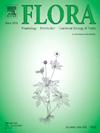Challenging the 'Immunity Hypothesis': Primary or secondary parasitism as different survival strategies for the harlequin mistletoe Lysiana exocarpi (Behr) Tiegh
IF 1.7
4区 生物学
Q3 ECOLOGY
引用次数: 0
Abstract
The relationship between host plants and parasitic plants is considered a unique and fascinating model to explore different aspects in plant physiology, especially concerning water relations and nutrient use, given that host and parasite share these resources. An even more intriguing dynamic occurs when a parasite parasitizes another parasite (epiparasitism). In theory, these epiparasites should show even more specialized physiological functions to be capable to withdraw water and nutrients from the hemiparasite, such as maintaining even lower water potential and dealing with stronger nutrient imbalance. Here we studied leaf morpho-physiological responses of the Australian harlequim mistletoe (Lysiana exocarpi) and box mistletoe (Amyema miquelii) acting as hemiparasites on pink gum (Eucalyptus fasciculosa) and Lysiana exocarpi as an epiparasite on A. miquelii parasitizing E. fasciculosa. We explored the water and nutrient use and partitioning between the different plants involved (host–mistletoe–epiparasite). We found that L. exocarpi showed physiological and morphological differences that represent a more acquisitive strategy of resource use with higher stomatal conductance, water use efficiency, specific leaf area and K and Mg leaf concentration when growing as an epiparasite compared to the same species growing as primary parasite. Amyema miquelii traits remained constantly similar irrespective whether as primary parasite or with an epiparasite sharing its resources while the effect of the epiparasite is mostly depicted in its host's host species. In conclusion, our findings suggest that by adjusting some traits, epiparasitism is an alternative option for the harlequin mistletoe. Moreover, regardless of the host–parasite association, the primary host is the most affected by the epiparasitism.
求助全文
约1分钟内获得全文
求助全文
来源期刊

Flora
生物-植物科学
CiteScore
3.30
自引率
10.50%
发文量
130
审稿时长
54 days
期刊介绍:
FLORA publishes original contributions and review articles on plant structure (morphology and anatomy), plant distribution (incl. phylogeography) and plant functional ecology (ecophysiology, population ecology and population genetics, organismic interactions, community ecology, ecosystem ecology). Manuscripts (both original and review articles) on a single topic can be compiled in Special Issues, for which suggestions are welcome.
FLORA, the scientific botanical journal with the longest uninterrupted publication sequence (since 1818), considers manuscripts in the above areas which appeal a broad scientific and international readership. Manuscripts focused on floristics and vegetation science will only be considered if they exceed the pure descriptive approach and have relevance for interpreting plant morphology, distribution or ecology. Manuscripts whose content is restricted to purely systematic and nomenclature matters, to geobotanical aspects of only local interest, to pure applications in agri-, horti- or silviculture and pharmacology, and experimental studies dealing exclusively with investigations at the cellular and subcellular level will not be accepted. Manuscripts dealing with comparative and evolutionary aspects of morphology, anatomy and development are welcome.
 求助内容:
求助内容: 应助结果提醒方式:
应助结果提醒方式:


